 |
Home | Charity | Feedback |
Morocco:
Casablanca,
Chefchaouen,
Fes,
Midelt,
Rabat,
Volubilis
Casablanca, Morocco: French romance by Prakash Bang, Editor in Chief 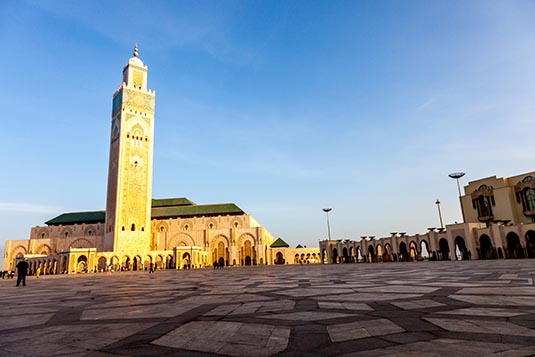 I was leading a group of 20 friends on a 10-day visit to Morocco. I had chosen the month of November for the trip as the climate won't be at its extreme and should be fine for the casual travellers like us. As per Google Maps we would be covering about 1700 kms. with a driving time of about 26 hours in all. Of course, with some detours and side trips, the distance and the time would be much more than anticipated. 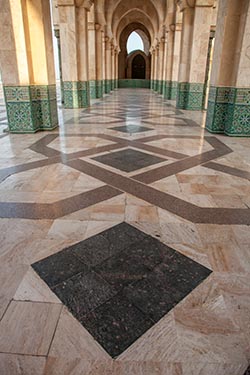 Since members of the group came from different parts of the world, our meeting point was Casablanca as it is conveniently connected internationally. Our ground arrangements were in good hands of Peak DMC; we had at our disposal a comfortable bus, experienced driver and his assistant and of course a guide who would always be with us throughout the trip.
Since members of the group came from different parts of the world, our meeting point was Casablanca as it is conveniently connected internationally. Our ground arrangements were in good hands of Peak DMC; we had at our disposal a comfortable bus, experienced driver and his assistant and of course a guide who would always be with us throughout the trip.
On the day of arrival, after a quick briefing at our Hotel Barcelo, we headed out for a dinner at the famed Rick's Cafe - a restaurant that was designed to recreate the bar made famous by Humphrey Bogart and Ingrid Bregman in the movie classic 'Casablanca'. Morocco is the land of meat eaters; so, for vegetarians informing the restaurants in advance is a good idea. Located on Morocco's Atlantic coast, Casablanca is the country's largest city and busiest port with a population of over 3.5 million. For many, the name Casablanca evokes the romance of the 1945 film; but the reality of the city is a little different. Although its older neighbourhoods boast their fair share of picturesque French colonial and traditional Moroccan architecture, Casablanca's modern identity is all about progress and development. It is a thriving business centre full of cosmopolitan arts venues, restaurants and nightclubs. 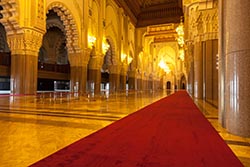 Casablanca came to prominence as one of the most important cities of the Berber Barghawata kingdom in the mid-8th century. In the 14th century, it was used as a key port by the Merinids; and in the 15th century it became known as a safe harbour for pirates. Casablanca came under Portuguese control shortly afterwards. In 1755, the town was largely destroyed by an earthquake. It was rebuilt by Sultan Mohammed ben Abdallah and was colonized in the 20th century by the French. After serving as a strategic port during the Second World War, Casablanca gained independence along with the rest of Morocco in 1956.
Casablanca came to prominence as one of the most important cities of the Berber Barghawata kingdom in the mid-8th century. In the 14th century, it was used as a key port by the Merinids; and in the 15th century it became known as a safe harbour for pirates. Casablanca came under Portuguese control shortly afterwards. In 1755, the town was largely destroyed by an earthquake. It was rebuilt by Sultan Mohammed ben Abdallah and was colonized in the 20th century by the French. After serving as a strategic port during the Second World War, Casablanca gained independence along with the rest of Morocco in 1956.
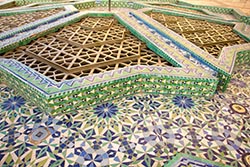 We would leave Casablanca the next morning. Since it was on our itinerary to visit many other Moroccan towns famous for their madinas and kasbahs, it was OK to skip Casablanca's old quarters. What was important, of course, was a visit to the Hassan II mosque.
We would leave Casablanca the next morning. Since it was on our itinerary to visit many other Moroccan towns famous for their madinas and kasbahs, it was OK to skip Casablanca's old quarters. What was important, of course, was a visit to the Hassan II mosque.
This opulent mosque, built at enormous expense, is set on an outcrop jutting over the ocean with a 210-metre-tall minaret that's a city landmark. It's a showcase of the finest Moroccan artisanship: hand-carved stone and wood, intricate marble flooring and inlay, gilded cedar ceilings and exquisite geometric mosaic tilework. 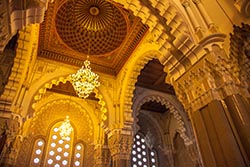 Indeed, one of the largest mosques in Africa, it can hold 105,000 worshippers – 25,000 inside, the rest on the outside courtyards. Built and partially funded by King Hassan II the mosque complex was designed by French architect Michel Pinseau, took six years to build and was completed in 1993.
Indeed, one of the largest mosques in Africa, it can hold 105,000 worshippers – 25,000 inside, the rest on the outside courtyards. Built and partially funded by King Hassan II the mosque complex was designed by French architect Michel Pinseau, took six years to build and was completed in 1993.
Its dramatic location overhanging the ocean waves echoes verse from the Quran, which states that God’s throne was built upon the water. Believers pray on a floor that can be heated when necessary and can feel the breeze through the retractable roof in warmer months. 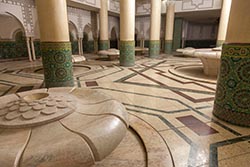 The size and elaborate decoration of the prayer hall is simply spectacular. A team of more than 6000 master craftspeople was assembled to work on the mosque, delicately carving intricate patterns and designs in fragrant cedarwood from the Middle Atlas and pink granite from Agadir. The gates were made from brass and titanium, and the ablution fountains in the basement, which are shaped like huge lotus flowers, were carved from local marble.
The size and elaborate decoration of the prayer hall is simply spectacular. A team of more than 6000 master craftspeople was assembled to work on the mosque, delicately carving intricate patterns and designs in fragrant cedarwood from the Middle Atlas and pink granite from Agadir. The gates were made from brass and titanium, and the ablution fountains in the basement, which are shaped like huge lotus flowers, were carved from local marble.
One of two Moroccan mosques open to non-Muslims, multi-language guided tours are conducted outside prayer times for modestly clad visitors. There’s also a small museum showcasing the craftsmanship involved. Tours last around 45 minutes and are conducted in French, English, German and Spanish, and take in the prayer hall and subterranean ablutions rooms. It was 11 AM and was time to drive to Chefchaouen our next town on the itinerary. The drive would take about 5 hours to cover the distance of about 340 kms. Though the plan was to go direct our driver was kind enough to make a detour via Rabat - the capital city of Morocco. Generally, Rabat is not on a typical tourist map but since it was doable, we took our chance. Casablanca Image Gallery  Photo viewer Photo viewer
|
|
|
Home |
Charity |
Feedback
Privacy Policy | Terms of Usage © YoGoYo.com. All rights reserved. |








